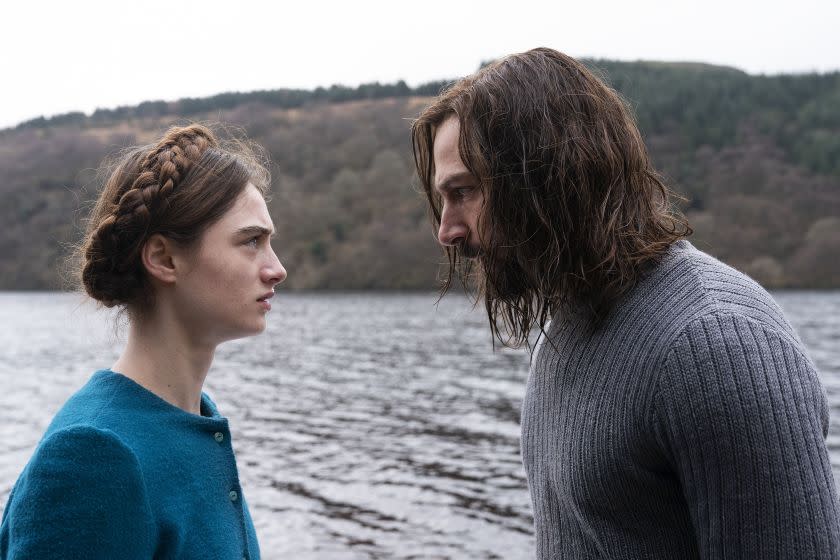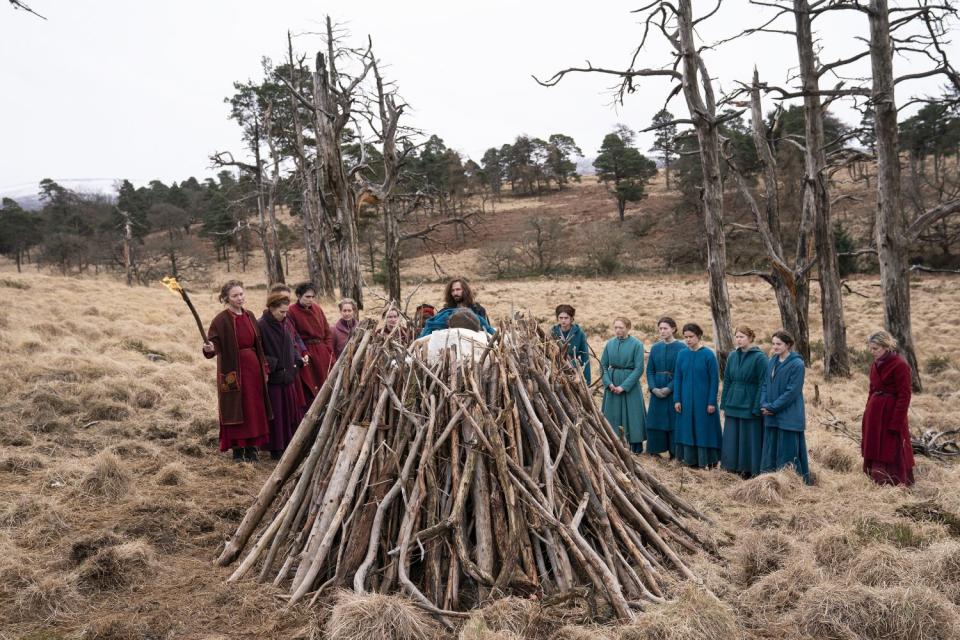Review: Creepy cult drama 'The Other Lamb' spins a beautiful but murky parable of female revenge

The young actress Raffey Cassidy has a gaze that is somehow both inquisitive and ferocious; it poses questions that could cut through glass. If you saw her in “Vox Lux” or “The Killing of a Sacred Deer,” you might recall her presence more than anything else, her watchful intelligence and eerie, preternatural calm. She’s as arresting as ever in the visually immaculate if dramatically muddled chiller “The Other Lamb,” in which she plays a teenager who has grown up within an incestuous, polygamous sex cult — part “Handmaid’s Tale,” part “Martha Marcy May Marlene” — and gradually realizes that the experience may not be great for her long-term well-being.
The viewer will arrive at this conclusion mere moments after the story begins, probably around the time Selah (Cassidy) and some of her many sisters, wearing near-identical blue dresses, make their way across a mountain landscape toward the cluster of wooded cabins they call home. By the time they’re sitting down opposite their mothers, who are all clad in heavily symbolic red, the creepiness factor is off the charts. These women are the obedient wives and daughters — who will themselves eventually become wives — of a man known only as the Shepherd (Michiel Huisman of “Game of Thrones”). His shoulder-length Jesus locks are hardly the extent of his self-styled Messiah act.
Selah is the Shepherd’s favorite daughter, though not having come of age, she has yet to receive the “grace” that he alone can give. The administering of that grace — said to purify each young woman after the apparent defilement of her first period — is mercifully left to the imagination. While the cult in question is not exactly religious, the Shepherd’s agenda can be read, in some ways, as a grotesque derangement of the 23rd Psalm. (The verse “He maketh me lie down in green pastures” has rarely taken on such revolting overtones.) The lambs, for their part, are literal as well as figurative: The women tend their own small flock of sheep, one of which Selah finds mauled to death on a hillside one afternoon in a bloody omen of the horrors to come.
From the outset, then, you want Selah to run screaming from this hellish commune — or, better yet, to take a blowtorch to the Shepherd’s rod and staff. You also want explanations, or at least clues, that Catherine S. McMullen’s screenplay is teasingly slow to provide. But Cassidy persuasively inhabits the psychological bondage of a young woman who, like her sisters, has known no life other than this one. Besides allowing no one to criticize or contradict him, the Shepherd has also decreed that no one but he can tell stories of any kind: Owning one’s narrative, after all, would be tantamount to a kind of freedom.

The filmmaker telling this particular story is the Polish writer-director Malgorzata Szumowska, whose tense and provocative earlier features (including “In the Name Of” and “Elles”) have explored the outer limits of youthful sexuality and forbidden desire, as well as the bonds between the spirit and the flesh. Here, the exquisite stillness of her compositions (the work of her longtime cinematographer, Michal Englert) works in elegant counterpoint to the tensions roiling beneath the surface. The deftly balanced colors and symmetrical compositions seem to mock the characters and their increasingly dire straits, imposing a sense of order that will soon be revealed as unsustainable.
It’s worth noting that the word “Selah” appears repeatedly throughout the Psalms; you could think of it as a kind of “amen,” an occasion to pause and reflect. The Selah of “The Other Lamb” acts as a more subversive kind of interrupter. Her coming of age is marked by eerie visitations and dark, hallucinatory visions (including much sub-“Carrie” menstrual imagery), and her smarts allow her to see the cracks and fissures in the Shepherd’s not-so-grand design before the other women do. One mother (Denise Gough), cast aside and banished by the Shepherd, does her part to steer Selah toward the light.
All this is absorbing enough without generating much in the way of real terror, tension or surprise. As an outside threat sends the Shepherd and his flock packing and in search of a new home, it becomes clear that this dread-soaked parable of female vengeance can end in only one way, which may be why Szumowska doesn’t linger on the violent final passages. The most powerful moment comes earlier, when Selah peers out toward a road and catches a cruel glimpse of freedom, of the life that might have been — and still might be — hers. As a study in atmospheric seclusion, “The Other Lamb” is beautifully crafted enough to hold your attention, but you can’t shake the feeling that Selah’s next chapter — and Cassidy’s — might well be the more interesting movie.

